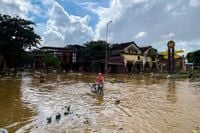Central Vietnam is reeling from the aftermath of catastrophic floods that have left at least 13 people dead and 11 others missing, as communities in the historic cities of Hue and Hoi An begin the arduous process of recovery. Record rainfall over several days has inundated more than 116,000 homes and submerged 5,000 hectares—approximately 12,400 acres—of vital crops, according to Vietnam’s disaster management agency. The devastation has not only claimed lives but also upended daily life, crippled infrastructure, and brought the region’s thriving tourism sector to a near standstill.
The deluge, which struck at the tail end of Vietnam’s rainy season, hit hardest in the UNESCO-listed former imperial capital of Hue and the ancient trading port of Hoi An. Photographs published on state media paint a grim picture: entire neighborhoods underwater, with some houses submerged up to their roofs. In Hoi An, where narrow, lantern-lit streets usually bustle with tourists, floodwaters began to recede on Friday, October 31, 2025, allowing residents to finally begin clearing thick layers of mud and debris from their homes and businesses.
“I have witnessed floods many times, and this is the worst I’ve ever seen,” said Tran Van Tien, a 60-year-old Hoi An resident, speaking to Reuters. His sentiment was echoed by many who have lived through Vietnam’s stormy seasons, but few can recall such a rapid and destructive rise in water levels. For locals like Tien, the experience is both familiar and shocking—proof that even communities accustomed to seasonal flooding can be caught off guard by nature’s fury.
Tourism, the lifeblood of Hoi An’s economy, has been hit especially hard. The city, which welcomed more than 4.4 million visitors last year—nearly 3.6 million of them from abroad—now faces empty streets and shuttered businesses. "Floodwater rose too quickly, causing significant property damage," said Nguyen Thi Thuy, a hotel manager whose business has been closed since Monday, October 27, 2025. Thuy’s story is not unique. Most hotel bookings have been canceled, and the prospect of reopening depends on how quickly the waters recede and cleanup efforts progress. “I hope that floods won’t happen again so that we can reopen our hotel… We all rely on tourism here,” she added, underscoring the deep uncertainty facing the community.
Vietnam’s vulnerability to extreme weather is well documented. The country’s rainy season, stretching from June to October, routinely brings storms and flooding, but officials warn that this year’s rainfall has been exceptional. The government reported that in some areas, rainfall could exceed 500 millimetres—about 20 inches—through late Saturday, November 1, 2025. This relentless downpour has overwhelmed drainage systems, damaged roads and rail lines, and cut off power to several communities, leaving many residents isolated and in urgent need of assistance.
According to the government’s disaster agency, the scale of destruction is staggering. More than 116,000 houses have been inundated, forcing families to evacuate or seek shelter on upper floors. Crops—an essential source of income and food security—have been submerged, raising fears of longer-term economic hardship in the region. Roads and railways, vital for movement of people and goods, have been damaged or rendered impassable, further complicating rescue and relief efforts.
State media has circulated images of the devastation: boats navigating what were once roads, rooftops peeking above muddy floodwaters, and lines of residents carrying belongings to higher ground. In Hue, the former seat of Vietnamese emperors, cultural landmarks and centuries-old architecture have not been spared. The city’s status as a UNESCO World Heritage site underscores the significance of the loss—not just in terms of human suffering, but also in the potential damage to irreplaceable heritage.
As the waters slowly recede, the immediate focus has shifted to cleanup and recovery. In Hoi An, residents armed with shovels and brooms are working tirelessly to clear debris. Yet, the sense of urgency is tempered by anxiety: heavy rain is forecast to continue, with daily rainfall still expected to exceed 500 millimetres in some areas through late Saturday. This ongoing threat has residents and officials on edge, bracing for the possibility of further flooding and additional damage.
The human toll is sobering. As of Friday, October 31, 2025, the official death count stands at 13, and 11 people remain unaccounted for. The search for the missing continues, but the challenging conditions—damaged infrastructure, lingering floodwaters, and the risk of further rain—have made rescue operations perilous and slow.
For the people of central Vietnam, the floods are a harsh reminder of the region’s exposure to the whims of weather and the increasing unpredictability of climate patterns. While local communities have developed resilience and coping strategies over generations, the scale and speed of this disaster have tested even the most seasoned residents. Many, like hotel manager Nguyen Thi Thuy, are left hoping for a swift return to normalcy but remain acutely aware of the risks that lie ahead.
Vietnam’s government has mobilized disaster response teams and issued warnings about the potential for even greater rainfall in the coming days. Relief efforts are underway to deliver food, clean water, and medical supplies to the hardest-hit areas, but logistical hurdles remain. Damaged roads and power outages have hampered the distribution of aid, and some communities remain isolated as authorities work to restore access.
Looking beyond the immediate crisis, questions are being raised about how to better protect vulnerable regions from future disasters. Experts point to the need for improved infrastructure, early warning systems, and community preparedness programs. At the same time, the economic impact—particularly on tourism and agriculture—will likely be felt for months, if not years, as families and businesses struggle to rebuild.
As central Vietnam faces the long road to recovery, the resilience and determination of its people are on full display. From residents clearing mud from ancient streets to hotel workers hoping for the return of visitors, the community’s spirit remains unbroken, even in the face of unprecedented loss. For now, all eyes are on the skies, hoping that the rains will finally relent and give this battered region a chance to heal.






